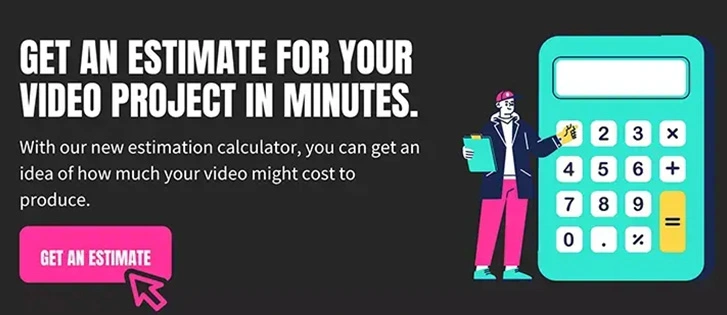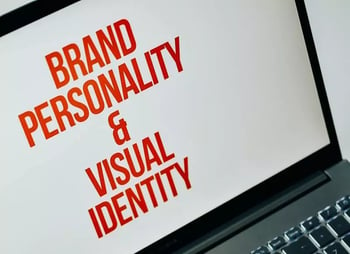Marketer's Guide to the Corporate Video Production Process
Jumping into corporate video for the first time? Or brushing up on the video production process? This guide will teach you how to plan for success.
Using video for corporate messages is very powerful. The way to get the most out of your content is to plan for success before you even think about picking up a camera.
Guess what? Great video marketing isn't just about cameras and microphones.
It's mainly about planning, forethought, and a kick-ass strategy.
So here's where you're at: you need video as part of your marketing strategy, but aren't sure where to start.
Put down the camcorder and relax.
Whether you're:
- Jumping into corporate video for the first time
- Looking to brush up on the video production process
I promise we'll get through this together.
This massive guide will walk you through, in detail, the 9 steps you need to take to achieve awesome things with your video content (or, how to stop worrying and learn to love video planning).
Whether you're working with an experienced corporate video production company (full disclosure: we are one!) or a freelance filmmaker, or producing one piece of video content or many, the steps to successful video are always the same.
I'm going to show you the whole process from start to finish.
Ready? Let's jump in.
Warning: this post is pretty epic. To jump between sections, just use these links:
STEP 1: DECIDE ON YOUR VIDEO OBJECTIVE
STEP 2: RESEARCH YOUR TARGET AUDIENCE
STEP 3: WORK OUT YOUR CORE MESSAGE
STEP 4: YOUR VIDEO STRATEGY
STEP 5: YOUR PRODUCTION BRIEF
STEP 6: THE CREATIVE BIT
STEP 7: SCRIPT AND STORYBOARD
STEP 8: ANALYTICS AND HOSTING
STEP 9 : VIDEO ACTIVATION
Step 1: Decide on Your Video Objective
What's the first step to doing anything in marketing?
Working out what you're doing it for. Your endpoint.
Surprise, surprise (or not really), it's no different with video.
Before you do anything else you need to come up with an objective for your video content. Why do you want video in the first place? What are you aiming to achieve?
Don't fall into the trap of wanting to create video for all the wrong reasons.
Here are some really, really bad reasons for wanting video (they might be part of why you want video, but they shouldn't be the only reasons):
- You just feel like you need video
- You want to be able to show off to your friends and family
- You're jealous because everyone else has video
- You don't think your marketing efforts are really awesome until they include video
Why are these reasons so terrible?
Well, they're not firm goals. There's no way to measure your success against them, because there's no way to measure how much less jealous you feel or how much more awesome your marketing is with video (at least not objectively).
That means you're setting yourself up for failure before you've even started.
If you want to create video and your only motivation is one of those goals I listed up there, stop right now. Cramming your objectives into a video-shaped box is doing it all backwards.
Let's set you up for success instead.
Video is Form, not Content
You need to remember that video itself isn't content, it's form.
What the hell does that mean?
Well, content is basically what you want to say. Form is how you say it.
Video is just one way of getting your message across. You could also express that message through an infographic, some copy, or a funny GIF (effectiveness may vary per format).
That means video isn't limited to a certain type of content, message, or topic.
In other words, video is more flexible than a ferret doing yoga. You can say anything through video.
So rather than thinking: We should create a video! It could explain our services! it's better to think: We should explain our core services to potential customers! and then work out the best way to express that content, whether that's through video or otherwise.
Basically, start with your content first, rather than your form.
In practice, that means you should know what you want to achieve and what you want to tell your audience before you even start to think about if video is the best way to get there.
That might be a bit controversial coming from a video production company. But it's the right way to do it.
And that's why these first few steps of the video production process (AKA the planning) are so vital.
Okay. Let's move onto actually setting out your objectives.
i) Identify Your Business Situation and Issues
First, bust open a new Google or Word document. We're going to fill this bad boy with the reasoning behind your video objectives.
Your objectives are most likely to blossom naturally from a problem, weakness, or opportunity for your business.
That's why you may want to do an up-to-date SWOT analysis of your business first of all.
Whether you decide to go that in-depth or not, you need to ask yourself how your business and its marketing efforts are doing and where your strengths and weaknesses currently lie.
Go ahead and fill this into the template or your document.
Be as detailed as you can, but don't worry about getting every single thing down. This doesn't need to be War and Peace. It just needs to give an accurate view of where your business is at, where it's acing things, and where it could improve.
For example, you might note that your business is doing well at generating traffic to your site, but having a hard time converting that traffic into paying customers. Note it down.
ii) Pick Your Problem
Call me Ishmael, because it's time to find your own Moby Dick.
From the information you've filled out, decide which of the issues facing your business you want to try and fix.
(Or which opportunity you want to go after.)
Following on from the example above, you might choose to improve the poor conversion rates on your product pages. Whatever it is, write it down.
iii) Link it Back to Strategy
Now's the time to make sure your chosen issue fits into your overall business or marketing strategy.
Do you have any wider goals currently in place that your video content could contribute towards?
Hint: the answer should be yes.
You want to be certain that whatever videos you create tie into your bigger aims and are relevant to where you're heading as a business.
So write down which higher-level goals your video content will feed into.
For example, by tackling poor conversion rates you might be helping to meet your business goal of generating 200 new customers this year.
iv) Construct Your Objective
Okay, it's time to get that objective down.
Keeping your problem or opportunity in mind, turn it into an objective that will also help achieve your bigger goal.
Most importantly, you need to make sure your objectives are SMART.
That means:
- Specific (not vague)
- Measurable (ideally containing statistics you can track)
- Achievable (realistic considering the circumstances)
- Relevant (tied into your wider business goals)
- Time-bound (within a set deadline)
So if you've got a bad conversion rate on one of your product pages, your objective might be:
To improve the conversion rate on our product page to 3% by March.
v) Specify How You'll Measure Success
This is something people often forget to do, but it's so key to track how your video content is performing.
Be sure to note down specifically what numbers, statistics, or video metrics you'll need to keep an eye on to see how and when you hit your objectives.
And use the exact figure that you're aiming to achieve, so there's no room for confusion.
In this case we would specify:
We track the conversion rate of our product page. By March we want to achieve a conversion rate of 3%, which is 2 percentage points higher than our current conversion rate of 1%.
Add this to your document too.
vi) Make Note of Your Stakeholders
Finally, write down anyone who might need to be aware of or sign off on your video objectives.
This might be a Marketing Director, the owner of the business, or your direct superior. Or all three.
Whoever will need to know, it's pertinent to start getting them involved now. That way you won't come up against any surprise roadblocks further down the road.
And if you're lucky enough to have sole control over your video content, leave this part blank!
Some Common Video Objectives
Okay, I've shown you the process you need to follow to come up with your objectives, but you might still be struggling for inspiration. Well, the truth is: video can be used to achieve almost anything.
At the end of the day your objectives are going to rely heavily on your marketing strategy and the overall aims of the business.
But to help get you started, here are some of the most common objectives for video:
- Converting leads
- Increasing sales
- Improving user engagement
- Raising brand awareness
- Launching a new product or service
- Providing customer support
Don't feel limited by these. Video content can reach any goal, if done right (and thank goodness that's what we're doing here).
Step 2: Research Your Target Audience
As a marketer, you know your target audience like a close friend you don't call often enough.
That's pretty lucky, because your audience might well be the single most important aspect of your video content. And you're going to have to get to know them even better to do this thing right.
If you haven't done enough research into your target audience, there's no way you'll be able to create video that appeals to them and engages them. That speaks to their heart.
In practice that means going way beyond simple demographics like age, gender and location.
It means getting to know your audience as people.
Reinforce Your Personas
You probably already have detailed marketing personas to represent your ideal customers.
We're going to build on this and make sure you have enough primary research to really pinpoint your target audience and understand what makes them tick.
First of all, let's do some digging into a few places you might not have thought to look before.
i) Quora
First, head over to Quora.com. Type your business offering, product or service into the Quora search bar.
This might take a few tries to get the most useful results, but keep going.
For example, if you sell analytics software you could try 'analytics software', 'tracking software', 'analytics', 'business analytics', etc.
Make note of the questions that seem like ones you could answer with your product, service or expertise.
(You should probably keep a list of them in a new document, as we're going to be adding to this.)
This gives you a great indication of two things:
- The most common problems your target audience face that you can solve
- And the way they naturally phrase and consider those problems
All of this is precious evidence towards how your audience think and what really concerns them.
ii) Reddit
Next we're going to delve into Reddit for some more real questions asked by real people.
Like on Quora, type your offering, product or service into the search bar to the top right of the page. You'll get results something like this:
Click through to any subreddits (the results at the top) or single posts (the results at the bottom) that look like they might have potential.
You can also click to view more of these results to squeeze yourself further down the rabbit hole.
You'll probably find better results from the subreddits, especially if you hit on ones that are tailored specifically to your industry or niche, but sometimes you'll get lucky with the single posts too, like the post from the Analytics Consultant I found above.
Scan through the single posts to find questions or comments that are interesting, and add them to your research document.
Do the same with the subreddits. Here you'll be able to browse posts and click through any that you think could reveal more insightful questions or comments.
Be aware that most subreddits are a mixture of links to articles and personal posts.
You can spot the personal posts, which are more likely to be natural questions, because their title will be followed by (self.subredditname).
Make sure you've got your finds noted down, because the next part is going to require actual human interaction (!).
iii) Interviews and Feedback
This is probably the most important step of the process, and hopefully you'll already have done parts of it before.
Now we want to get up close and personal with real people (who belong to your target audience) to ask them what their biggest problems are related to your offering, and how you can help solve them.
Here are some ways you can go about getting this information:
- Take your customers out to coffee and conduct an informal interview
- Ask questions to your audience on social media
- Send out a survey to customers or leads asking for feedback
- Speak to sales and/or support about the most common questions they have to answer
- Search social media for conversations or questions about your industry
And here are some questions that may be helpful for prising answers out of your target audience:
- What's the biggest problem you encounter at work/home regarding X topic/industry?
- What skills and abilities do you use every day?
- What do you wish you knew more about?
- What are you responsible for?
- What does it mean to be successful for you?
- Where do you go to learn new things?
Obviously, you'll need to tweak those questions a little based on your business and the product or service you offer. But you get the idea.
Generally the more open-ended the questions the better. Don't box your interviewees into a corner, but let them grapple with the questions in their own way.
(Pro tip: often the way they answer the question can be just as illuminating as what they say.)
IV) Use AI
OR, you can save yourself loads of time and get AI to do the research for you.
When you think of robots with jobs, you probably picture some distant futuristic workplace where humans are no longer needed. Or maybe you picture your Roomba happily hoovering your floor.
In any case, rather than removing the need for human input, AI is increasingly supplementing and easing the efforts of marketing teams all over the world.
In fact, in 2020, 84% of marketing leaders said they use AI, up 186% from 2018, when the rate was 29%.
What are the benefits of using AI?
-
INCREASED ROI
AI helps marketers create a more predictive customer analysis, meaning they can design customer journeys that are way more tailored and targeted. This in turn increases the ROI by driving leads to the next best step for them and ultimately supercharging their experience.
By being able to go deeper when analysing customer journey data, marketers can truly understand what leads want faster and maximise their ROI without risking wasting: A) loads of time on conducting the analysis themselves, and B) huge chunks of their budget on efforts that don't work out.
-
A BETTER UNDERSTANDING OF YOUR CUSTOMER
A.I. can gather audience insights from all over the digital realm to find patterns in behaviours, preferences and interests. All this can help inform your campaigns, what marketing activities to prioritise, and even how your brand presents itself.
-
MORE PERSONALISATION OPPORTUNITIES
Of course, this then leads to opportunities to give your audience better personalisation, which has time and again been proven to be increasingly what customers want from a brand or supplier.
Loads of brands are already using AI to personalise their websites, emails, social media posts, video, and more. A good example of this is product recommendations, which are a powerful AI marketing practice that makes your customer's experience way more personalised and relevant to their wants and needs.
-
SMARTER AND FASTER DECISION MAKING
AI helps marketers conduct data analysis much faster than humans can, and at the same time, guarantees accuracy. This helps your team to focus on strategic initiatives that lead to more confident, effective, data-driven campaigns without the faff.
As it's able to collect and track real-time tactical data, marketers can even make decisions in real-time with AI, without having to wait until campaigns end. You can determine what to do next based on these data-driven reports, leading to smarter decisions being made by your team.
GET AI-POWERED AUDIENCE INSIGHTS FROM Venture
AI takes billions of data points and turns them into actionable intelligence, including audience psychographics, behaviour, influence, content consumption and more.
It does this by analysing the endless amount of online content on social media platforms, blogs, or other platforms, collecting on-site interactions, purchase behaviours, past interactions, communications, referral sources, and tonnes more.
Pull Out Common Threads and Insights
It can be hard to keep track of all this qualitative data, but you're going to want to make a note of the most important points in your research document.
Now what do we do with it?
A little bit of data analysis. A little bit of sleuthing. A little bit of clever guesswork.
(Put on your Sherlock Holmes deerstalker hat if you want.)
Look back through your notes. Can you see any common themes, or repeated answers, running through them? Try to identify the commonalities that tie your target audience together.
These should be real insights into why your audience act or feel the way they do.
For example, in the samples above we found that lots of people were concerned about improving their analytical skills.
Whatever you find, add these discoveries to your existing marketing personas, either by attaching your research document or pasting the information directly into your persona profiles.
You should phrase what you've learned about your target audience as a whole as if you were describing a specific real life person:
Business Owner Brian worries that he's missing out on key insights from his Google Analytics data, and is constantly looking to learn more about how to analyse his business performance.
The more you can describe your target audience like real people, the less likely you'll be to forget that they are real people, and the easier you'll find it to connect with them through your video content.
If you're not yet 100% confident in the detail of your personas, I recommend you work your way through it.
The truth is, until you feel like you understand what your audience most desires, what they're afraid of and what their biggest problems are, you probably won't be successful at engaging with them.
So don't be scared to get close. Just... y'know, don't be weird about it.
Step 3: Work Out Your Core Message
You've got your video objectives, and hopefully now you feel even more in tune with your target audience.
It's time for the big one: to decide exactly what you want to say to that audience.
This falls at the intersection between what you want to achieve and what your audience wants to know.
That's why the basic rule here is to keep your main objective, as well as your target audience, in mind at all times. Our example objective was:
To improve the conversion rate on our product page to 3% by March.
And here's what we discovered about our target audience:
Business Owner Brian worries that he's missing out on key insights from his Google Analytics data, and is constantly looking to learn more about how to analyse his business performance.
So how do we get from that to your core message?
What Your Audience Should Feel, Think, Do
You want to achieve your objective, obviously.
In that case, what action do your target audience need to take to make it a reality? And what state of mind will lead them to that action?
In other words, what do you want your target audience to:
- Feel?
- Think?
- Do?
Let me give you an example. If we want to increase our conversion rate on our product page to 3% (and considering what we found from our research) then we want our audience to:
- Feel: invigorated, excited to get started
- Think: our product will offer more in-depth analysis and training than Google Analytics
- Do: purchase our analytics software
Boil Down the Core Message
Next, we have to work out the one thing your audience needs to know to encourage them to feel, think and act that way. The best corporate videos out there usually have an emotional element that showcases what their brand stands for and resonates with their target audience.
I strongly suggest you focus on a single core message. The more precision you have on what you want to say, the less diluted your point will be.
Think of your video content like a laser, dividing your video between different messages is like separating the laser into different beams. Each message becomes weaker overall.
But if you leave the laser as a single beam, your message emerges far stronger.
So what's your core message? What do you need to get across to your target audience? How do you want to make them feel? What do you want them to think? What should they do?
Back It Up With a Message Map
You might find it useful to use a message map to structure your core message, as best explained by author, speaker and general user of words Carmine Gallo:
Basically, the message map is a deceptively simple tool that helps you refine and strengthen your core message. It works in any medium, but I particularly enjoy using it for video.
Your message map is going to look a bit like a spider who's been in a tragic accident. Something like this:
You want to put your core message in the big circle at the top. In our example this was:
Our analytics software offers data and support that is better than Google Analytics.
Now you want to back that up with three or four sub-messages that support your core message, like a little backing group for your main star.
Underneath, add any specific details (like statistics or examples) that reinforce your sub-messages.
Here's what it might look like when you're done:
The idea behind the message map is that you can explain the entire thing in as much detail as you want, depending on the amount of time you have.
When it comes to video, this helps to keep things open and means you can base the length/complexity of your content on your audience and objective too. We'll get to that in a bit.
Is Video the Right Format?
Now's the time for a bit of an existential crisis.
Remember what I said about video being a form, or way of expressing your message?
So far we've been assuming that video is the form you want to use to get across what you want to say, but now let's make sure.
Here's what we've worked through:
- Your objective
- Your target audience
- Your core message
Keeping all of those in mind, are we still certain that video is the right way to:
- Achieve your objective?
- Reach and engage your target audience?
- Express your core message?
Don't freak out at this stage. Because video is so flexible, it can be used to accomplish almost anything. It's pretty much impossible that you've managed to find a goal, audience and topic completely incompatible with the format.
However, just like any format video has its own strengths and weaknesses, and you might realise that another form of content could be more effective.
STEP 4: YOUR VIDEO STRATEGY
All the above boils down to strategy, which is at the heart of your video production. Without a clear strategy filled with the above insights, your video is going to be just a load of pretty imagery. Which is great and all, but it'll probably miss the mark when it comes to speaking clearly to your target audience.
Your video marketing strategy will ultimately be what guides you — in terms of your budget, your timelines, your production processes, your conversion metrics, and even where your video is going to live. In other words, all the things you need to create a bangin' brief for the creatives who will be working on your corporate video.
If you've not done that strategic thinking yet, we can help you look at your objectives, goals and audience and support you on this journey. We manage projects where clients have had no video experience, all the way through to those very familiar with the medium and what’s involved.
Have a gander at our strategy services and get in touch!
STEP 5: YOUR video PRODUCTION BRIEF
Now, this document is probably the most important part to get right. If you want to create a corporate video that grabs attention and achieves your goals, you need to combine all of your thoughts into one place to ensure no important planning is missed.
Whether you're creating video internally or working with a video agency, your brief is vital to make sure everybody involved is working towards the same goal. It's where you can jot down everything your agency will need to get started, including examples of videos you like or trends you've been inspired by.
With decades of video production experience the team at Venture know what a great video brief looks like - so we've uploaded a video briefing template for you to download, free of charge.
Remember that the more detail you can include in your brief before production begins, the more likely your video is to be a success that engages your audience and meets your goals.
Our simple video brief template asks you all of these questions in even more depth, with preview examples. So now you know how to write a video production brief (and why), download our template and get started today!
STEP 6: THE CREATIVE BIT
Want to know how the corporate video production creative process works? Whilst every video production agency is different, we can give you some insight into how we do things here at Venture:
I) PROJECT BRIEFING
First, your video production team will begin by understanding your destination through your brief. They should be using it as a guiding principle throughout the whole of the video production process.
II) CREATIVE DEVELOPMENT
Then, your video production team will begin to develop strategic and creative ways of telling your story. They'll take your brief and get to work researching and creating mood boards to develop a key creative idea based on real insights.
III) CREATIVE PRESENTATION
Once ideas have been sparked, the real excitement begins as your video team presents their thoughts and creative ideas to you for feedback.
STEP 7: SCRIPT AND STORYBOARD
Once you’re happy with the direction of your video, it’s time for those working on your video (i.e. your chosen video production agency, motion designers and animators) to get to work on your video scripts and storyboards.
What’s a storyboard, you ask? A storyboard is a visual representation of your video sequence broken down into individual panels. It’s pretty much a series of ordered drawings that include camera direction, dialogue, and other important details. Essentially, it’s where the creatives sketch out how a video will unfold, shot by shot.
In order to tell your story in the most compelling way possible, you’ll need to ensure that the script for your video syncs well with what you have in mind visually.
STEP 8: ANALYTICS AND HOSTING
Once you publish your shiny new video on Wistia and the views begin to rush in, you'll have access to a whole host of advanced metrics to work out how close you are to your goals.
STEP 9: VIDEO ACTIVATION
A brilliant video won't go very far on its own. Planning where your video will live is vital to its success with your target audience. This is where you need to make sure your content is hitting your target audience in the right place, at the right time.
To start you off, let’s get thinking about some of the following questions, so you can decide where it's most worthwhile to invest your time, money and effort.
I) WHAT DO YOU WANT TO ACHIEVE?
Every business has its own goals, from boosting awareness to increasing sales to better engagement on social media platforms.
Your goal will ultimately shape what success looks like to you and whether your campaign has gone well. But it also defines how you should distribute your video.
Think about your sales funnel: consider whether you're trying to raise awareness, push leads, drive decision-making, or keep customers interested, then decide how your corporate video can help you do it.
For example, if you're launching something new? You should think about promoting your video with paid social. Helping customers out with an explainer video? Put long-form content on YouTube for them to view while they research.
II) WHO IS YOUR AUDIENCE?
90% of customers agree product video aids buying decisions, and 85% want more video from brands (Forbes), but who, exactly, is your audience?
Take a step back and build a clear picture of the group you're trying to reach. Think about the channels they use, the shows they watch, and ultimately, which platforms are worth pursuing.
Is there anything your target customer is looking for or expecting from your sector? Knowing the answers to all these questions will help you figure out the best platforms to achieve your goals.
For example, you might know you want to use social media advertising to boost awareness, but your target market is under 18s. So, you're better off using TikTok or Instagram, which have more users in that demographic than Facebook.
Or, if you know you want to speak to an audience that watches DIY shows, you might think about spending on pre-roll ads or Sky AdSmart.
Ultimately, to reach the right people you have to be in the right place, because if you don't think it through from the start, you risk wasting your budget, and your chances.
III) DO YOU HAVE THE RIGHT FORMATS?
Once you've answered the questions above, you should have an idea of how you want to activate your video. But just as one video won't work for all people, on a technical level, it won't work for all channels, either.
That doesn't mean you necessarily have to create additional content, though. It's often a case of adapting what you have for different platforms.
It's worth setting aside some budget to create edits of your video, so it can be trimmed and tailored for all kinds of applications (more on that on p. 7 of our Video Activation Guide).
If you're not confident or comfortable with doing this, ask us to step in and take the reins.
IV) WHAT'S YOUR BUDGET?
93% of marketers agree video is an important part of their marketing strategy (HubSpot), but whether you're using social media, TV (be that connected or traditional) or another channel, budget is crucial.
It all depends on what you're trying to achieve and which platforms you use. But, even a small budget will stretch further than you think.
TV is no longer just for big brands; there are lots of advertising options on connected TV, streaming and on-demand platforms, which allow you to target specific audiences too.
And on social media, you might want to invest in more targeted advertising to reach particular people, or to give your video content wider reach.
You'll always need to set some money aside for media spend, or you won't be able to get your video out there, but if you're unsure how to use it wisely, we can help.
Ready to start your corporate video production?
Whether you've got a spark of an idea or a fully-formed plan, our door's always open. And it all starts with a conversation. Call us up or send an email to book a kick-off meeting, where we'll build a picture of your brand, talk you through our process, timings and costs, and decide the next steps.

Written by Emily Malone Marketing Manager for Venture — a full-service video production agency that specialises in producing creative videos & campaigns that get real results.






















